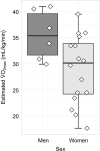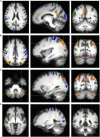Cardiorespiratory fitness is associated with fMRI signal in right cerebellum lobule VIIa Crus I and II during spatial navigation in older adult women
- PMID: 36506472
- PMCID: PMC9727394
- DOI: 10.3389/fnagi.2022.979741
Cardiorespiratory fitness is associated with fMRI signal in right cerebellum lobule VIIa Crus I and II during spatial navigation in older adult women
Abstract
Spatial navigation is a cognitive skill critical for accomplishing daily goal-directed behavior in a complex environment; however, older adults exhibit marked decline in navigation performance with age. Neuroprotective interventions that enhance the functional integrity of navigation-linked brain regions, such as those in the medial temporal lobe memory system, may preserve spatial navigation performance in older adults. Importantly, a well-established body of literature suggests that cardiorespiratory fitness has measurable effects on neurobiological integrity in the medial temporal lobes, as well as in other brain areas implicated in spatial navigation, such as the precuneus and cerebellum. However, whether cardiorespiratory fitness modulates brain activity in these regions during navigation in older adults remains unknown. Thus, the primary objective of the current study was to examine cardiorespiratory fitness as a modulator of fMRI activity in navigation-linked brain regions in cognitively healthy older adults. To accomplish this objective, cognitively intact participants (N = 22, aged 60-80 years) underwent cardiorespiratory fitness testing to estimate maximal oxygen uptake ( O2max) and underwent whole-brain high-resolution fMRI while performing a virtual reality navigation task. Our older adult sample demonstrated significant fMRI signal in the right and left retrosplenial cortex, right precuneus, right and left inferior parietal cortex, right and left cerebellum lobule VIIa Crus I and II, right fusiform gyrus, right parahippocampal cortex, right lingual gyrus, and right hippocampus during encoding of a virtual environment. Most importantly, in women but not men (N = 16), cardiorespiratory fitness was positively associated with fMRI activity in the right cerebellum lobule VIIa Crus I and II, but not other navigation-linked brain areas. These findings suggest that the influence of cardiorespiratory fitness on brain function extends beyond the hippocampus, as observed in other work, to the cerebellum lobule VIIa Crus I and II, a component of the cerebellum that has recently been linked to cognition and more specifically, spatial processing.
Keywords: aging; cardiorespiratory fitness; cerebellum; fMRI; navigation.
Copyright © 2022 Kern, McMains, Storer, Moffat and Schon.
Conflict of interest statement
The authors declare that the research was conducted in the absence of any commercial or financial relationships that could be construed as a potential conflict of interest.
Figures




Similar articles
-
Cardiorespiratory fitness is associated with cortical thickness of medial temporal brain areas associated with spatial cognition in young but not older adults.Eur J Neurosci. 2024 Jan;59(1):82-100. doi: 10.1111/ejn.16200. Epub 2023 Dec 6. Eur J Neurosci. 2024. PMID: 38056827 Free PMC article.
-
Interaction Between Hippocampus and Cerebellum Crus I in Sequence-Based but not Place-Based Navigation.Cereb Cortex. 2015 Nov;25(11):4146-54. doi: 10.1093/cercor/bhu132. Epub 2014 Jun 19. Cereb Cortex. 2015. PMID: 24947462 Free PMC article.
-
A functional MRI study of motor dysfunction in Friedreich's ataxia.Brain Res. 2012 Aug 30;1471:138-54. doi: 10.1016/j.brainres.2012.06.035. Epub 2012 Jul 3. Brain Res. 2012. PMID: 22771856
-
Explicit and Implicit Emotion Processing in the Cerebellum: A Meta-analysis and Systematic Review.Cerebellum. 2023 Oct;22(5):852-864. doi: 10.1007/s12311-022-01459-4. Epub 2022 Aug 23. Cerebellum. 2023. PMID: 35999332 Free PMC article.
-
Meta-analytic connectivity modelling of functional magnetic resonance imaging studies in autism spectrum disorders.Brain Imaging Behav. 2023 Apr;17(2):257-269. doi: 10.1007/s11682-022-00754-2. Epub 2023 Jan 12. Brain Imaging Behav. 2023. PMID: 36633738 Free PMC article. Review.
Cited by
-
Cardiorespiratory fitness is associated with cortical thickness of medial temporal brain areas associated with spatial cognition in young but not older adults.Eur J Neurosci. 2024 Jan;59(1):82-100. doi: 10.1111/ejn.16200. Epub 2023 Dec 6. Eur J Neurosci. 2024. PMID: 38056827 Free PMC article.
References
LinkOut - more resources
Full Text Sources

